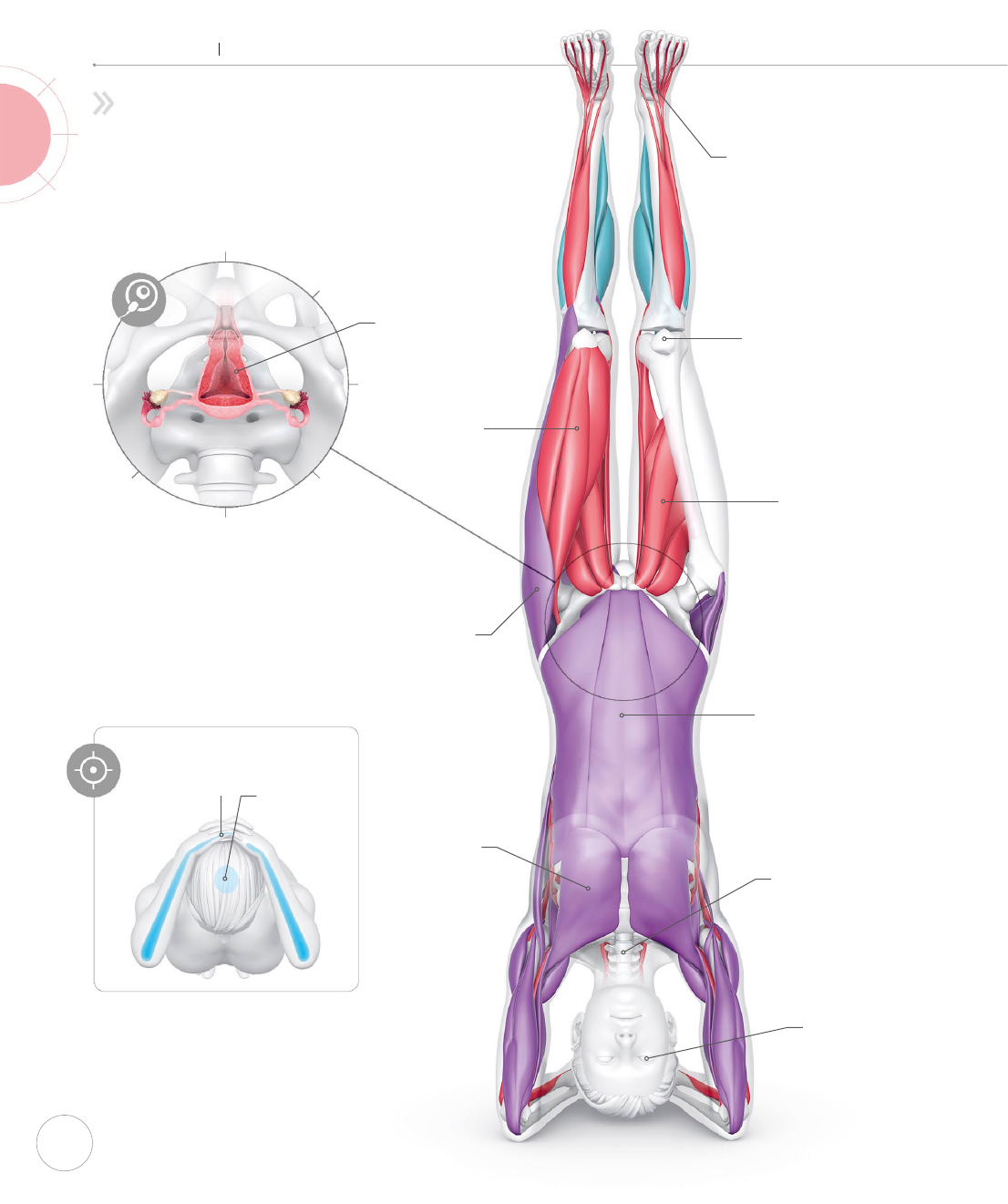
THE ASANAS Inversions
This full inversion turns you
physically upside down.
A multitude of benets can be ascribed to this pose: from
helping you breathe more eciently to strengthening
your upper body—especially the muscles around your
shoulder joints—and your core.
HEADSTAND
Sirsasana
THE BIG
PICTURE
This pose strengthens your arms and
shoulders. Your core and thighs activate
to stabilize your body at its center,
preventing you from falling to either
side. Despite the name, it is your arms
that are supporting your weight in this
pose, not your head.
Lower legs
Your ankle dorsiexors
engage, to dorsiex your feet
and extend your toes. Your
calf muscles are in a
stretched position.
Thighs
Your quadriceps engage
to extend your knees. Your
hip adductors engage to
adduct your hips, while your
abductors stabilize, keeping
you from falling over to
either side.
VARIATION
This version of the pose
has a reduced risk of
falling and takes weight
o your upper body. Push
your forearms into the
floor, lower your heels,
and lift hips up and back.
Allow your head to drop.
Feet hip-
distance apart,
heels reach
down
Forearms
support
upper body
weight
Gastrocnemius
Tibialis anterior
Soleus
Extensor hallucis longus
Ankle
Extensor digitorum longus
Hip
Gluteus maximus
Gluteus medius
Gluteus minimus
Pectineus
Adductor longus
Vastus medialis
Adductor magnus
Rectus femoris
Gracilis
Knee
KEY
Joints
Muscles
Engaging
Engaging while
stretching
Stretching
US_128-129_Headstand_01.indd 128 20/09/2018 21:10

129
ALIGNMENT
For the safety of your
neck, your head is
either not touching or
barely brushing the
ground, with little to
no weight on it. Your
spine, including your
neck, is neutral.
Pressing into
floor to lift up
through body
Neck neutral
curve
Torso
Your abdominals engage to
stabilize your spine in a neutral
position and compress your
abdominal organs inward. Your
spinal extensors engage to
resist falling forward.
Arms
Your rotator cu muscles
are engaging dynamically to
stabilize your scapulae and
shoulder joints. Your
shoulder
exors
stabilize your shoulders
in exion. Your brachialis,
biceps, and brachioradialis
engage to ex your elbows.
Your triceps stabilize as you
press into the oor.
Neck
Your cervical extensors
engage to hold your spine
in a neutral curve and
stabilize your head.
Pelvis
neutral
Heels
press up
Cervical extensors
Spine
neutral
Rectus abdominis
Transversus abdominis
Spine
Spinal extensors
Serratus anterior
Pectoralis major
Teres minor
Infraspinatus
Shoulder
Elbow
Brachioradialis
Brachialis
Biceps brachii
Triceps brachii
Deltoids
US_128-129_Headstand_01.indd 129 20/09/2018 21:10

130
HEADSTAND
Sirsasana
Abdominal
muscles engage to
maintain balance
Tensor fasciae
latae stabilizes
your hips
Slowly transitioning
in and out of
the pose reduces
neck pressure
Kneecaps
face forward
Gaze is forward
Endometrium
lines uterus
Menstruation
From a yoga perspective, inverting during
menstruation could interfere with the natural
downward ow of energy (apana vayu), which
could be reason enough to avoid inversions
during menstruation. However, from a
medical perspective, there is no scientic
evidence yet to support these claims. Choose
what feels right for you.
Pressure and balance
A modern way of practicing Headstand, and
perhaps the safest, involves only allowing 0–10
percent of your weight to rest on your head. Cradle
your head in your forearms so it barely touches the
ground. Press rmly into your forearms, reaching
your feet upward energetically.
Your head
should carry
little to
no weight
Cradle your
head to keep it
from pressing
into the ground
Hip adductors
engage to draw
legs together
Heels are lifted
toward ceiling
Quadriceps
tighten to keep
legs lifted
Pectoralis major
engages and
stretches as the
chest expands
CLOSER LOOK
Headstand can be safely practiced with little to no pressure
on the head and neck. It has many health benefits, from
improving respiratory and shoulder function to helping
you better regulate your blood pressure.
ANTERIOR VIEW
US_130-131_Headstand_02.indd 130 02/11/2018 14:04

131
THE ASANAS
Inversions
Diaphragm
pushes on
to lungs
Diaphragm
compressed
Intestines
push down
with gravity
Compressed diaphragm
In this orientation to gravity, your respiratory
diaphragm works hard when you inhale to
push against the weight of your abdominal
organs. This eort strengthens your
diaphragm, making breathing more
ecient with practice.
The commonly injured
supraspinatus has a
chance to heal
Headstand
variations use
muscles like
teres minor
Rotator cu strength
In an 8+-year clinical trial, participants
with rotator cu injury used Headstand,
or a modied variation, to strengthen. This
resulted in a reduction in pain for the
majority of participants, and prevented
surgery for many.
Feet are flexed
(in dorsiflexion)
Hamstrings may
engage slightly while
in a neutral position
to maintain balance
Middle and lower
trapezius engage
to stabilize your
shoulder blades
Gluteal muscles
also help
maintain balance
Fingers
interlace
POSTERIOR–LATERAL
VIEW
Infraspinatus
US_130-131_Headstand_02.indd 131 02/11/2018 14:04
..................Content has been hidden....................
You can't read the all page of ebook, please click here login for view all page.
